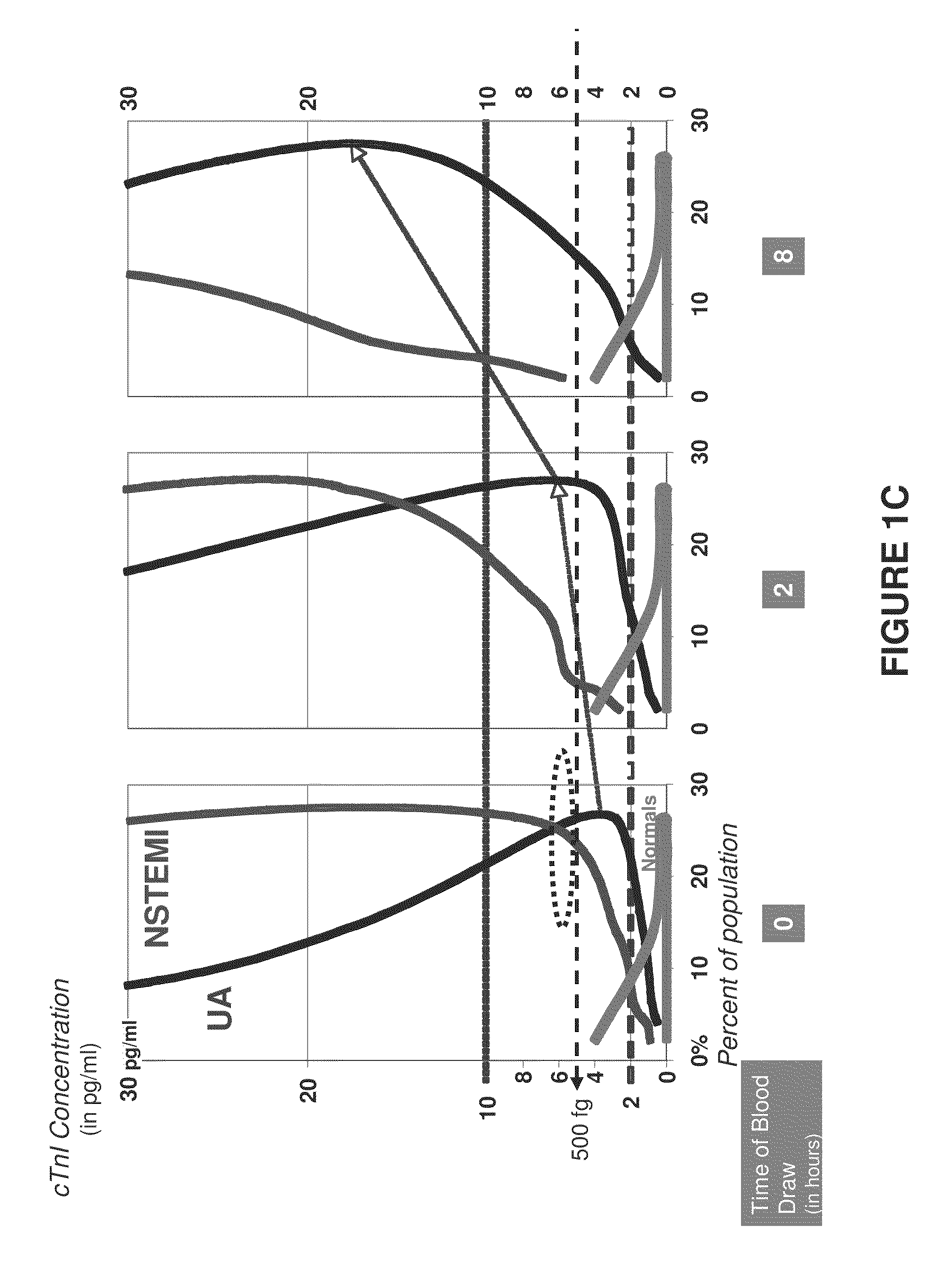Methods and assays to assess cardiac risk and ischemia
a technology of applied in the field of methods and assays to assess cardiac risk and ischemia, can solve the problem that detection assays rely on signal generation technologies that lack sufficient sensitivity to d
- Summary
- Abstract
- Description
- Claims
- Application Information
AI Technical Summary
Benefits of technology
Problems solved by technology
Method used
Image
Examples
example 1
cTnI Assay Sensitivity as a Function of Time
[0108]In the example shown in FIG. 1A, known amounts of cTnI (50, 5, 0.5 and 0 pg / mL of cTnI NIST standard spiked into troponin depleted serum) were introduced to an array of anti-troponin antibodies (81-7 antibody analyzed) deposited on Codelink substrates (SurModics, Eden Prairie, Minn.) in separate assays. For each cTnI concentration, three different incubation times were tested (0.5 hours (hr), 1 hr, and 2 hrs). After capture of the cTnI molecules, a x-cTnI probe comprised of 13 nm diameter gold particle functionalized with 19C7 anti-troponin antibodies was added to each sample. Detection of the gold particle labeled troponin was achieved by catalytically reducing silver onto the surface of the gold particles followed by imaging light scattered by the silver amplified gold particles using a surface scanner such as a Tecan LS (Tecan USA) or a Verigene ID (Nanosphere, Northbrook, Ill.) detection system. These data demonstrate that differ...
example 2
Measurements on Patient Samples
Methods
[0109]The nanoparticle-based assay quantifies an optical signal resulting from selective detection of the cTn1 molecule through analyte-specific capture of gold nanoparticle probes, followed by subsequent signal enhancement. Briefly, capture antibody (mouse monoclonal, Nanogen) was contact-spotted in triplicate onto CodeLink activated microarray slides along with controls in ten sub-arrays and assembled into a hybridization chamber. Fifty microliters of sample was incubated for 90 minutes at 35° C. Wells were washed with 0.3% Tween 20 in phosphate-buffered saline (PBS) pH 7.4, then incubated with detection antibody (rabbit polyclonal, Nanogen) in 1% BSA, 0.3% Tween in PBS pH 7.4 and incubated for 20 minutes. Wells were washed again, then incubated in 150 pM gold nanoparticles for 10 minutes. Slides were washed, followed by a 150 mM sodium nitrate, pH 7.5 wash. Capture substrates were immersed in signal enhancement reaction mix for 9 minutes at 1...
example 3
Differential Measurement of cTnI Epitopes Using Selected Specific Antibodies and Diagnostic Algorithms
[0114]In this example, a cTnI sample (50 pg / mL of cTnI NIST standard spiked into troponin depleted serum) was introduced to an array of anti-troponin antibodies deposited on Codelink substrates (labeled Capture Ab), FIG. 2. The capture antibodies have known specificities for various parts of the cTnI molecule, or different forms of the cTnI molecule, FIG. 2. After capture of the various cTnI molecules, a probe or probes functionalized with antibody to complementary parts of the molecules of interest were introduced. In this example, the secondary antibodies were attached to 13 nm diameter gold particles and introduced in separate assays. Each of the anti-troponin secondary antibodies (labeled probe Ab) binds to a unique epitope of the cTnI molecule. Capture of the probe(s) and the signal generated depends on the absence, presence and / or quantity of the cTnI molecules, parts or modif...
PUM
| Property | Measurement | Unit |
|---|---|---|
| concentrations | aaaaa | aaaaa |
| concentrations | aaaaa | aaaaa |
| concentrations | aaaaa | aaaaa |
Abstract
Description
Claims
Application Information
 Login to View More
Login to View More - R&D
- Intellectual Property
- Life Sciences
- Materials
- Tech Scout
- Unparalleled Data Quality
- Higher Quality Content
- 60% Fewer Hallucinations
Browse by: Latest US Patents, China's latest patents, Technical Efficacy Thesaurus, Application Domain, Technology Topic, Popular Technical Reports.
© 2025 PatSnap. All rights reserved.Legal|Privacy policy|Modern Slavery Act Transparency Statement|Sitemap|About US| Contact US: help@patsnap.com



